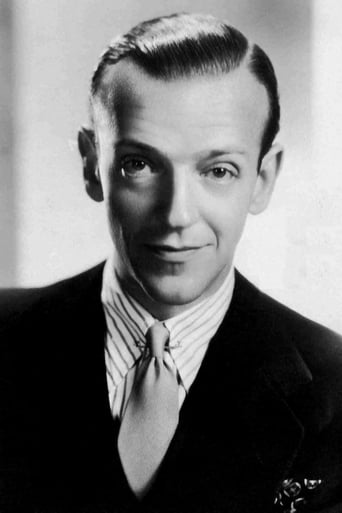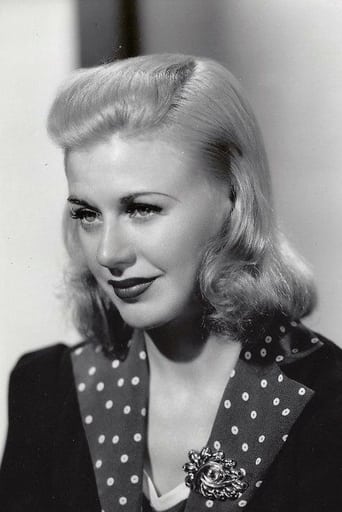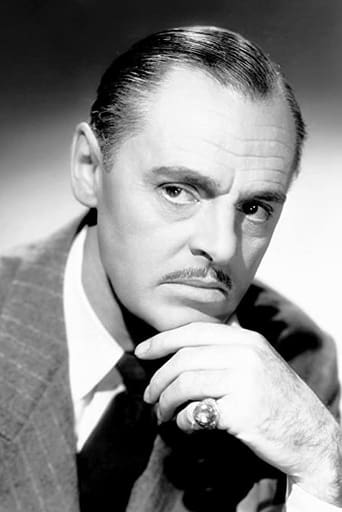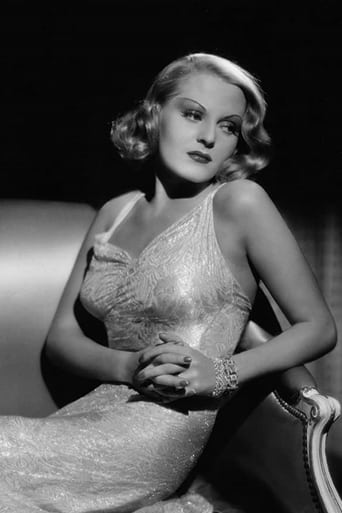CheerupSilver
Very Cool!!!
Solemplex
To me, this movie is perfection.
Listonixio
Fresh and Exciting
Chirphymium
It's entirely possible that sending the audience out feeling lousy was intentional
vert001
Somewhere I read that you'll think more highly of the Astaire/Rogers SHALL WE DANCE if it's the first of their movies that you've seen. Watching them in order leaves you with the impression that we've seen all this before, and what's more, that we've seen it all done better before as well.Unquestionably the great strength of the film is its musical score, by my count the fifth great musical score in a row for the series, but I'd have to agree with George Gershwin that it wasn't used very well. The main problem: Ginger and Fred don't dance together enough. Indeed, they only have one major duet in the whole movie, danced to 'They All Laughed'. It's a dandy, but even here they'd done comparable dances even more brilliantly in ROBERTA, TOP HAT AND SWING TIME. Of course, they also roller skate, and practically everyone adores the scene so who am I to knock it? Nevertheless, I miss them dancing, and the final duet to the title song comes and goes in about 30 seconds and only whets my appetite for more.After giving possibly the best performance in the entire series in SWING TIME, Ginger Rogers seems off here, irritable practically from beginning to end and considerably less fun than she was in the rest of the series (and during practically the rest of her career). The fact that she was the victim of an extortion attempt during the film's shooting may have had something to do with it. For those interested, she received a note demanding $50,000 or else they would kill Ginger's mother. Turning it over to the FBI, the fellow was apprehended at the scheduled drop point and turned out to be a sailor who was simply after the money, not the mother. He'd chosen Ginger because she was his favorite actress!But getting back to the movie, unlike in the rest of the series the songs are generally ill-fitted into the plot. While it's not unusual for Fred's solo to be a simple exhibition of his dancing ability that has little to do with the rest of the film, it is unusual for their major duets to move the plot exactly nowhere. As John Mueller points out in ASTAIRE DANCES, during the marvelous dance to 'They All Laughed', Ginger's character seems to be loosening up emotionally and moving closer to Fred's, the typical character movement in their up tempo numbers, but here she simply reverts to exactly where she had been before, i.e., simply resentful towards him. It's as if the dance had never happened. And what her motivation was for the reconciliation dance at the end I'll never understand. Would you be attracted to someone dancing with people wearing masks of you? I'd more likely call the nearest mental hospital.Speaking of motivation, what exactly would possess Fred to suddenly play hard to get once Ginger had finally invited him into her apartment on their wedding night? It did lead to probably the most artful shot that Mark Sandrich devised in the entire series (the one of them both hesitating before opposite sides of the door between them), but still...Ah, I'm sure I'm being too hard on SHALL WE DANCE. It's an elaborate production featuring two great performers, a few laughs, and terrific music. Who could ask for anything more?
Robert J. Maxwell
This must be judged one of the lesser examples of Fred and Ginger's work. Not that it's so poor it should be avoided. It's mostly that here they don't get together and dance often or intricately enough. The story makes little sense, but then none of their plots ever did. They're beside the point. But, anyway, this is the one in which Astaire imitates a Russian ballet dancer.George Gershwin was finally seduced into writing songs for a movie but the producers were wary. George had a tendency to write classical music, the kiss of death, even with jazz elements. He had to telegram the producers with a reassuring message that he was determined to "write hits." As it turned out, the tunes were pleasant enough, including "Slap That Bass" (in the simulacrum of a ship's engine room), and the title tune. Two of the songs became standards: "They Can't Take That Away From Me" and "Let's Call The Whole Thing Off". (You say tomayto and I say tomah-to.) In many ways, the most inventive tune has no lyrics at all. It's called "Promenade" and appears when Astaire and Rogers walk their dogs on the deck of an ocean liner.And if you've ever wondered what the design style known as Art Deco was, you should definitely check this movie out because the style is here in all its extravagance in the production design by Van Nest Polglase, who by this time was having trouble with the bottle -- the white sets and furniture, the frosted glass with etched deer, the uninterpretable curlicues, and all the rest of it. It's often claimed that it Polglase's sets, all the telephones and their cords were white. It's a bloody lie. The telephones here are silver.Anyway, Gershwin did manage to avoid anything resembling classical music -- a good idea since neither dancer was trained in ballet -- except for one number featuring Harriet Hoctor, a former Ziegfield Follies entertainer. OMG, what a woman. She dances well enough, fingertips aflutter, more skillfully and more flamboyantly feminine than Ginger Rogers, but then she does this THING with her back. En point, she bends backwards into such a lengthy arc that her head almost touches the floor -- and then she repeatedly taps the top of her head with the toe of her ballet slipper. It's a shtick that belongs in an out take from "The Exorcist." There's an earlier number with Astaire and Rogers on roller skates but I could never find much grace in roller skating.It begins slowly. It's an hour almost before the two leads dance together. And the end has dozens of women dancing around wearing masks of Ginger Rogers' face. The movie didn't make as much money as earlier outings. Time for something new -- but what? The pair tried a musical biography of a pair of real dancers whose time had long passed, Vernon and Irene Castle. Maybe what they needed was a stronger and funnier plot line. Rogers never got one in a musical. Astaire had only one, "The Bandwagon" in the early 50s. I remember when Ginger Rogers passed away. She merited one or two lines in Newsweek, hardly a whisper. It was fifty years or more since her heyday and Americans have little interest in vernacular history.
Claudio Carvalho
While in Paris, the famous dancer Pete "Petrov" Peters (Fred Astaire) meets the also famous tap dancer Linda Keene (Ginger Rogers) and he makes fun with her pretending that he is a Russian ballet master. He immediately falls in love with her and when he learns that she will travel to New York in an ocean liner, her arranges with his producer Jeffrey Baird (Edward Everett Horton) to travel in the same ship as Linda.In the departure, the annoying dancer and former affair of Petrov, Lady Denise Tarrington (Ketti Gallian), comes to the harbor and Petrov lies to her, telling that he has secretly married Linda, to get rid off Denise. However, Denise sends a telegram to the ship congratulating the couple and the lie turns into a gossip to the press. Now the lives of Petrov and Linda get very complicated with the situation."Shall We Dance" is another naive film of the couple Fred Astaire and Ginger Rogers, with delightful confusion and musical numbers. The gags are dated but funny and the film is a pleasant entertaining for cinema and dance lovers. My vote is six.Title (Brazil): "Vamos Dançar?" ("Shall We Dance?")
ackstasis
My second film starring Fred Astaire and Ginger Rogers {following the magnificent 'Top Hat (1935)'} confirms what I had initially suspected: I don't think I'll ever get sick of these guys! Throughout their careers, the pair co-starred opposite each other on no less than ten occasions, and 'Shall We Dance (1937)' marked their seventh collaboration. Brimming with catchy, stupendously-entertaining musical numbers, and a lightweight screwball storyline highlighted by a slew of accomplished comedy performers, the film was the brainchild of George Gershwin, who wrote the score, and his older brother Ira Gershwin, who penned the lyrics. Director Mark Sandrich returned, once again, to helm the production, which offers little different from the previous Astaire-Rogers pictures, but, in doing so, gave audiences precisely what they wanted. The society inhabited by Petrov and Linda Keene glitters with wealth, class and elegance, presenting American audiences – still suffering the effects of the Great Depression – with a sophisticated fantasy world in which they could immerse themselves.Notably, the film was the first in which Fred Astaire experimented with the blending of ballet and tap-dancing, his character expressing the desire to "combine the technique of ballet with the warmth and passion of this other mood." In this, Astaire proves moderately successful, though he obviously appears most comfortable when tappin' away on a hardwood floor, and it would eventually fall to Gene Kelly to perfect the combination in such films as 'An American in Paris (1951)' and, of course, 'Singin' in the Rain (1952).' Astaire's efforts are culminated in a wonderful and elaborate ballet-hybrid stage show, which features the title song, a Depession-era number that appeals to the audience to look on the brighter side of life by slipping on a pair of dancing shoes, and which concludes with a brief reprisal of "They All Laughed (At Christopher Columbus)" – an ode to the triumphant nature of love against all adversity. "Slap That Bass" is an unusual but gratifying mixed-race musical number, in which Astaire watches an African American jam-session in the engine room of their ship, demonstrating that happiness lies not with those with money, but rather with those possessing "rhythm."The story itself often wanders into rather silly territory {only Hollywood could possibly think to dispel marriage rumours by actually getting married}, but there is more than enough fun to go around. Edward Everett Horton is absolutely hilarious as Jeffrey Baird, Petrov's (Astaire) proud and indignant ballet manager, who not only detests the tap-dancing of which Astaire is so fond, but also disapproves of his budding relationship with Linda Keene (Rogers). Horton's reaction to seeing the scandalous nighttime photograph of the pair - a silent and completely unexpected offscreen pass-out - made me laugh so hard that I started to choke on my glass of water. Jerome Miller is also exceedingly likable as Linda's scheming manager, despite his suspect motivations in aiding Petrov's plight to marry her. Also amusing is Eric Blore, whose accommodating hotel manager Cecil Flintridge finds himself tormented by the conflicting gossip about the two stars' marital status, and later encounters much trouble trying to have himself bailed out of gaol. 'Shall We Dance' makes for an immensely enjoyable musical evening, and you'll find yourself humming "Let's Call The Whole Thing Off" for days afterward.






